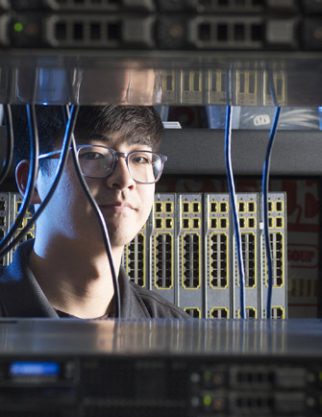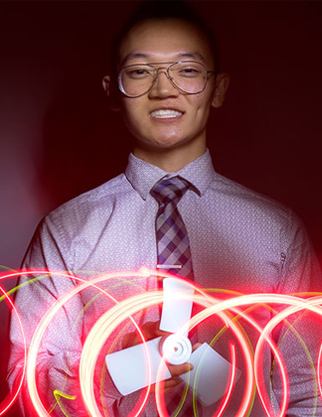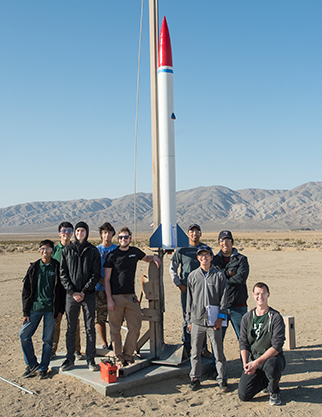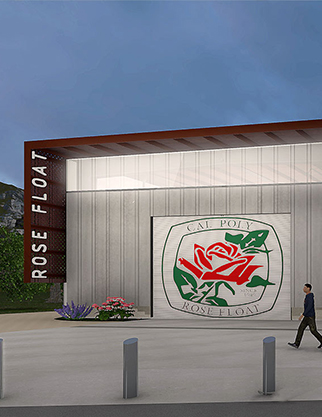Transportation
Pioneer
Professor Xudong Jia Merges His Passion for
Engineering, Teaching and Finding Solutions
Back in the early 2000s, Cal Poly Pomona students would wait at the Bronco Shuttle stop, not knowing where it was or when it would arrive.
Professor Xudong Jia engineered a better way.
With GPS technology emerging into the consumer electronics market, Jia tapped it to develop an online tracker to map every shuttle on campus and estimate arrival times.
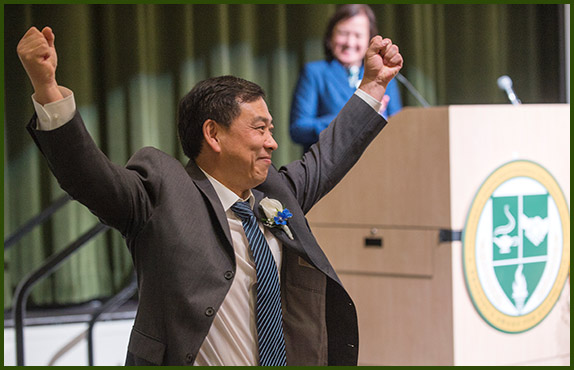
A Lasting Legacy
The civil engineering professor also used his transportation expertise and big data to help develop an early earthquake warning system for Southern California Edison. The class project with Cal Poly Pomona students to create the system’s software earned praise from former U.S. Sen. Barbara Boxer. Anytime that Jia, who has been chair of the civil engineering department since 2014, gets an opportunity to take his professional expertise and merge it with his passion for tapping big data to find solutions, he jumps at the chance — often taking his students along for the ride.
“After 20 years in the field of transportation, you learn that transportation gives you a system of thinking,” he says. “You develop a global perspective. Transportation helps force us to be one with a system approach. App to app, satellite signal to satellite signal, we always want to get everybody interconnected.”
Jia’s career also has involved striking a balance between the passion projects and his focus on ensuring students are academically successful and workforce ready.
Jia has been honored with four prestigious awards for his work. He has received $1.5 million to complete 42 externally-funded projects.
For the past decade, he has consulted on projects for the city and county of Los Angeles and advised L.A. Metro on its Regional Integration of Intelligent Transportation Systems, a big data network that exchanges information in real time between agencies that oversee freeway, traffic, transit and emergency services.
“I had this dream.
The dream was to make sure our students get real-world experience for their senior projects.”
Getting Students Real World Ready
Jia’s teaching and professional career have been a lesson in forging relationships.
“I had this dream,” he says. “The dream was to make sure our students get real-world experience for their senior projects.”
Since 2005, he has worked with Caltrans on myriad projects, including the design of the 10 Freeway Live Oak Canyon Road interchange in Yucaipa, the Interstate 215 4th Street interchange in Perris and the Interstate 15 Duncan Canyon Road Interchange in Fontana – all projects that have been built.
More than a dozen others are at various stages in the Caltrans’ review and approval process.
Duncan Canyon Road
Interchange in Fontana
Besides honing their engineering chops, the students gain essential skills such as communication, teamwork and public speaking, Jia says.
Caltrans District 7 Director John Bulinski, who oversees Los Angeles and Ventura counties, recalled meeting Jia in 2015 at a senior-projects showcase.
“I was blown away,” Bulinski says. “Here’s a group of students who had a good understanding of development of a project, preliminary understanding of the design phase, the constraints of a project, how to identify and assess risks. Back then, we weren’t hiring. I wanted to hire the whole group.”
Several Cal Poly Pomona civil engineering alumni work or have worked for Caltrans, Bulinski says.
“Dr. Jia provides real world exposure,” he says. “Theoretical is good and important, but the real-world application and getting students ready for real-world experience is key.”
With around 50 percent of Caltrans engineers, surveyors and regional planners nearing retirement, the demand for new hires is high, Bulinski says, adding that his district alone hired four or five Cal Poly Pomona students last year.
“Cal Poly Pomona students have a leg up on a lot of other students,” he says. “I see them as well prepared, ambitious, articulate. They have communication skills that are lacking in previous generations, including mine. There are several graduates who are already in management level positions.”
Bronco Shuttle
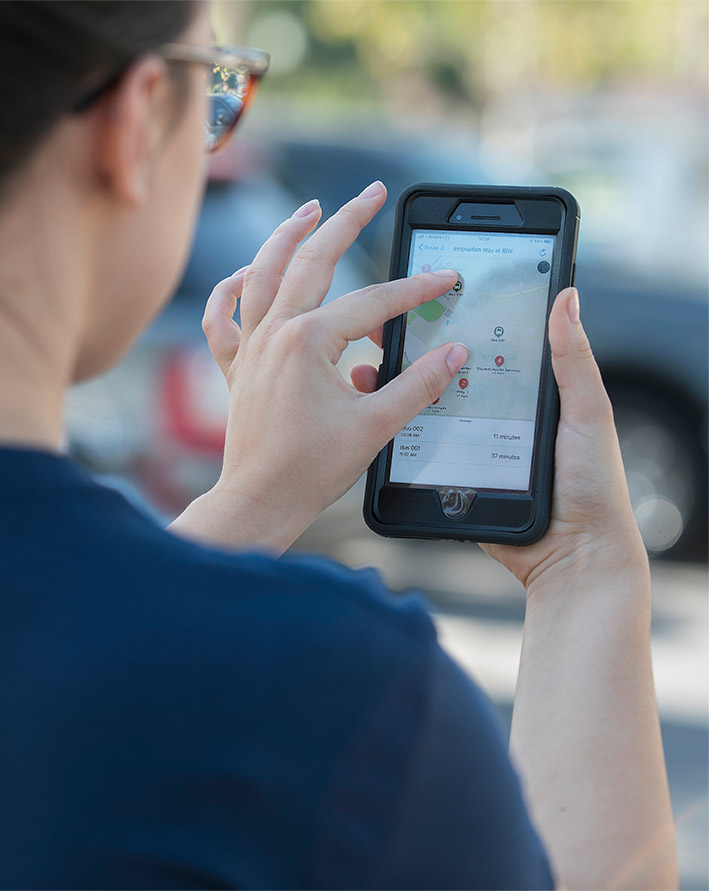
From 2005 to 2008, Jia applied for $500,000 in grant funding to equip Cal Poly Pomona’s campus shuttles with GPS monitors. This was at a time when GPS wasn’t as widespread as it is today, Jia says.
“We were pioneering with that,” he says. “I am very proud of that project.”
Through the grant, the university placed a digital sign at four route stops on campus that displayed how many minutes until the next shuttle’s arrival.
Jia’s work was the precursor to the current system, which allows students to track shuttle arrival times through a website and the CPP mobile app.
“His idea to implement the program for the campus was extraordinary,” says Glenn Shenker, director of Parking & Transportation Services at the time. “We are a large campus and we need a shuttle system, but to implement a program like this where you can track the buses now on a cell phone was a testament to his vision.”
Earthquake Early Warning System
In 2006, Jia headed a team of researchers on campus that developed a GIS-based earthquake warning system dubbed QuakeView for Southern California Edison.
The utility giant was developing an emergency preparedness system that tapped into a network of satellites to monitor seismic activity and warn of earthquake activities. Jia’s project took the data Edison collected and estimated which zones would be affected, enabling notification a few seconds before an earthquake strikes. This system has laid the foundation for the county’s current earthquake early warning systems.
Always looking a few steps ahead, Jia is developing a new system that will link traffic sensors with earthquake data and send it directly to cars so that drivers can hit the brakes.
“I hope to get that set up in 10 years,” he says.
Wildlife Crossing
In Temecula, freeways and expanded development have threatened mountain lions, especially when they cross the 15 Freeway.
Jia is working with Professor Wen Cheng and Associate Professor Lourdes Abellera, both in the civil engineering department, as well as a team of students, on a wildlife crossing solution.
The team presented options for crossing to Caltrans and the Department of Fish and Wildlife in May, 2019. These options are being reviewed by the state agencies.
UC Davis was doing ecological research and collecting data on mountain lions. The university reached out to Caltrans, who recommend Davis researchers team up with Cal Poly Pomona to help find a solution, Cheng said. Jia sent out an email requesting volunteers for the project, and Cheng, who has collaborated with Jia on ranking traffic projects for Caltrans funding and big data research on active transportation – walking and biking – stepped up.
“I am always asking if there is any way to apply my engineering to new fields,” Cheng says.
Cheng adds that he has an ease in collaborating with Jia because they have teamed up on so many projects and share interests.
“For research projects to have a successful completion, it requires all of the people in the group to work together at a high frequency and enjoy working together,” Cheng says. “He’s very energetic. I really enjoy working with him, his passion and his experience.”
Published February 7, 2020





